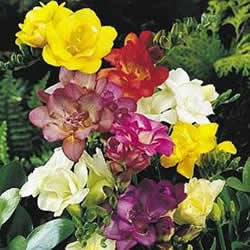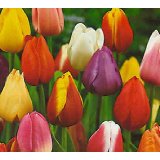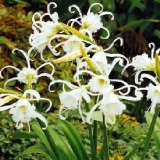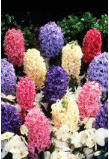Planting Location:
Light is one of the key considerations when choosing the locations for your bulb plantings. Some bulbs require full sunshine others require partial shade or even complete shade, read and follow the instructions on the bulb package.

Figure 1 - Double Freesia
Choose your locations, then choose bulbs that match the sunshine requirement of that location.
Early spring bulbs can usually be planted under trees as they will commence blooming prior to the trees having their full compliment of leaves and hence creating a full shading effect.
It may be noted that bulbs planted on the south side of your home will bloom ahead of the same bulbs planted on the north side of your home. In the same manner, bulbs planted in a valley will bloom later than bulbs planted on a hill. This is because cold air falls and will fill a valley area, while hot air rises and will aid in warming the bulbs.
Planting Depth:
Spring flowering bulbs should be planted at a depth of two to three times the bulb height, which for most of the larger bulbs such as tulips (Figure2) and daffodils that equates to a planting depth of approximately 8 inches deep.

Figure 2 - Mixed color tulips
Smaller bulbs will be planted at a depth of three to four inches deep. The planting depth is measured form the base of the bulb, resting on the soil in the hole or trench.
For summer flowering bulbs you should consult the specifications on the packaging as summer bulbs have substantially different planting depth requirements.
Daffodils, hyacinths (Figures 3 & 4) and tulips must be planted with the root plate pointing downward and the top or nose of the bulb pointing upward.

Figure 3 - Peruvian daffodils

Figure 4 - Mixed color Dutch hyacinths
It is recommended that to obtain the best planting that you till (Figure 5) the entire bed to loosen the soil to the correct depth. Insert the bulbs into the soil and then cover with fresh soil.

Figure 5 - Garden tiller
Tilling and loosening the soil in the entire bed provides for much better drainage, and allows for a better mixing of the fertilizer with the soil. By preparing the bed in this manner the planting will last for many years, whereas in many types of soils individual bulb planters do not work well, if they work at all.
Additional information on Planting Bulbs
Part 1 – Soil Preparation, Fertilizing;
Part 3 – Watering, Removing Foliage;
Part 4 – Staking, Mulching, Storing;
